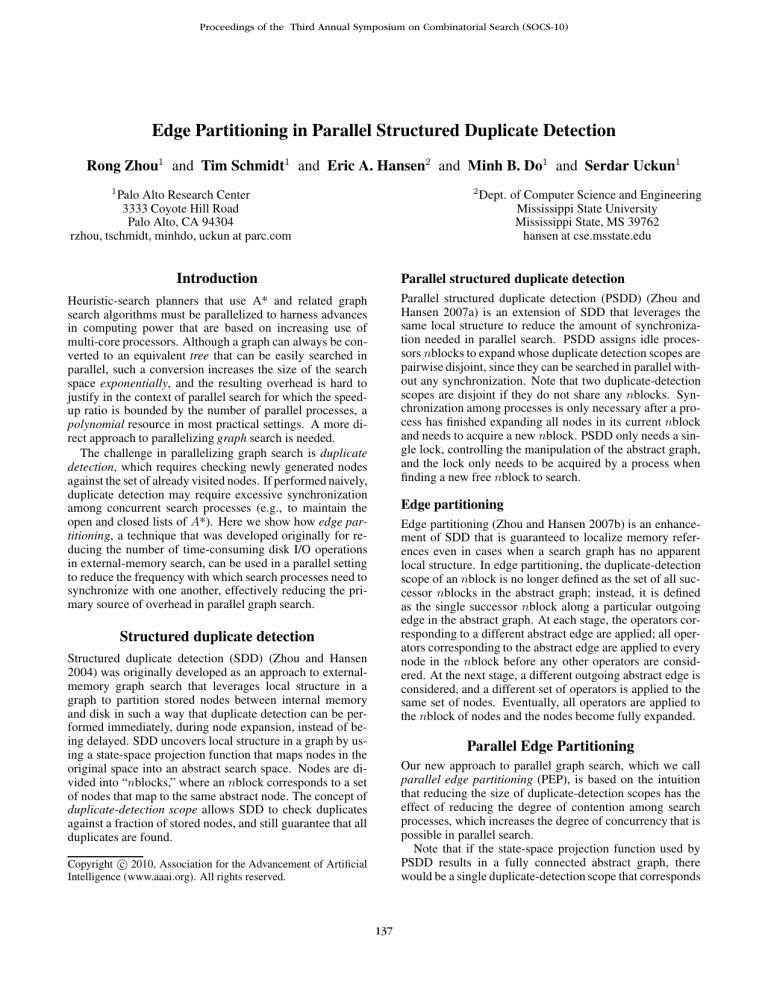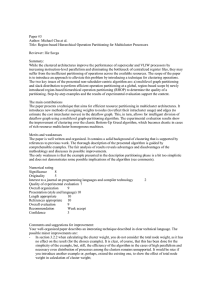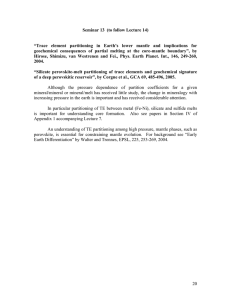
Proceedings of the Third Annual Symposium on Combinatorial Search (SOCS-10)
Edge Partitioning in Parallel Structured Duplicate Detection
Rong Zhou1 and Tim Schmidt1 and Eric A. Hansen2 and Minh B. Do1 and Serdar Uckun1
1
2
Palo Alto Research Center
3333 Coyote Hill Road
Palo Alto, CA 94304
rzhou, tschmidt, minhdo, uckun at parc.com
Introduction
Dept. of Computer Science and Engineering
Mississippi State University
Mississippi State, MS 39762
hansen at cse.msstate.edu
Parallel structured duplicate detection
Parallel structured duplicate detection (PSDD) (Zhou and
Hansen 2007a) is an extension of SDD that leverages the
same local structure to reduce the amount of synchronization needed in parallel search. PSDD assigns idle processors nblocks to expand whose duplicate detection scopes are
pairwise disjoint, since they can be searched in parallel without any synchronization. Note that two duplicate-detection
scopes are disjoint if they do not share any nblocks. Synchronization among processes is only necessary after a process has finished expanding all nodes in its current nblock
and needs to acquire a new nblock. PSDD only needs a single lock, controlling the manipulation of the abstract graph,
and the lock only needs to be acquired by a process when
finding a new free nblock to search.
Heuristic-search planners that use A* and related graph
search algorithms must be parallelized to harness advances
in computing power that are based on increasing use of
multi-core processors. Although a graph can always be converted to an equivalent tree that can be easily searched in
parallel, such a conversion increases the size of the search
space exponentially, and the resulting overhead is hard to
justify in the context of parallel search for which the speedup ratio is bounded by the number of parallel processes, a
polynomial resource in most practical settings. A more direct approach to parallelizing graph search is needed.
The challenge in parallelizing graph search is duplicate
detection, which requires checking newly generated nodes
against the set of already visited nodes. If performed naively,
duplicate detection may require excessive synchronization
among concurrent search processes (e.g., to maintain the
open and closed lists of A*). Here we show how edge partitioning, a technique that was developed originally for reducing the number of time-consuming disk I/O operations
in external-memory search, can be used in a parallel setting
to reduce the frequency with which search processes need to
synchronize with one another, effectively reducing the primary source of overhead in parallel graph search.
Edge partitioning
Edge partitioning (Zhou and Hansen 2007b) is an enhancement of SDD that is guaranteed to localize memory references even in cases when a search graph has no apparent
local structure. In edge partitioning, the duplicate-detection
scope of an nblock is no longer defined as the set of all successor nblocks in the abstract graph; instead, it is defined
as the single successor nblock along a particular outgoing
edge in the abstract graph. At each stage, the operators corresponding to a different abstract edge are applied; all operators corresponding to the abstract edge are applied to every
node in the nblock before any other operators are considered. At the next stage, a different outgoing abstract edge is
considered, and a different set of operators is applied to the
same set of nodes. Eventually, all operators are applied to
the nblock of nodes and the nodes become fully expanded.
Structured duplicate detection
Structured duplicate detection (SDD) (Zhou and Hansen
2004) was originally developed as an approach to externalmemory graph search that leverages local structure in a
graph to partition stored nodes between internal memory
and disk in such a way that duplicate detection can be performed immediately, during node expansion, instead of being delayed. SDD uncovers local structure in a graph by using a state-space projection function that maps nodes in the
original space into an abstract search space. Nodes are divided into “nblocks,” where an nblock corresponds to a set
of nodes that map to the same abstract node. The concept of
duplicate-detection scope allows SDD to check duplicates
against a fraction of stored nodes, and still guarantee that all
duplicates are found.
Parallel Edge Partitioning
Our new approach to parallel graph search, which we call
parallel edge partitioning (PEP), is based on the intuition
that reducing the size of duplicate-detection scopes has the
effect of reducing the degree of contention among search
processes, which increases the degree of concurrency that is
possible in parallel search.
Note that if the state-space projection function used by
PSDD results in a fully connected abstract graph, there
would be a single duplicate-detection scope that corresponds
Copyright c 2010, Association for the Advancement of Artificial
Intelligence (www.aaai.org). All rights reserved.
137
to the entire graph, and PSDD would be unable to search
in parallel because it would be impossible to find disjoint
scopes. But with edge partitioning, any duplicate-detection
scope contains only a single nblock. Therefore, the number
of concurrent search processes allowed in PEP is the number
of nodes in the abstract graph, regardless of its structure. For
any state-space projection function, it can be shown that PEP
is optimal in the sense that no other algorithm can achieve a
higher degree of concurrency without compromising duplicate detection.
PEP reduces the need for load balancing, because the
same nblock can be expanded by multiple processes in parallel, which is not the case for PSDD. This means that if one
nblock is significantly larger than others, PEP can assign
multiple processes to work on it, one for each outgoing abstract edge. Intuitively, this is equivalent to dividing a large
task into smaller pieces; the more pieces there are, the easier
it is to balance load and keep all processes busy.
PEP is deadlock-free by design, with a simple proof: it
breaks one of the four necessary conditions for a deadlock.
Recall the four conditions are (1) mutual exclusion, (2) hold
and wait, (3) no preemption, and (4) circular wait. The condition that is never satisfied in parallel edge partitioning is
“hold and wait,” because once a search process gets hold of
a single nblock (a unit resource in PEP) that is the duplicatedetection scope of an abstract edge, it has all that is needed
to proceed with node expansions and there is no waiting period for a deadlock to occur.
memory-efficient than A*. Our planner uses forward statespace planning to find optimal sequential plans, guided by
an admissible pattern database heuristic. We tested eight
benchmark domains from the biennial planning competition.
On average, PEP needs 10 times more incremental node expansions than PSDD needs full node expansions, yet PEP is
still 27% faster with 7 threads. On average, the size of the
abstract graph used in PEP is 10 times smaller than that used
in PSDD. This shows PEP can be more effective than PSDD,
even when using a coarser abstraction function.
We also compared PEP with recent parallel search algorithms, including HDA* (Kishimoto, Fukunaga, and Botea
2009) and PBNF (Burns et al. 2009). While using more
memory, both ran slower than PEP on all thread counts. We
also tested PEP on hard instances of the 15-Puzzle formulated as STRIPS planning problems. Previously, the best
domain-independent solver (Haslum et al. 2007) can solve
93 of them in hours. PEP can solve 95 of them in minutes,
using a much weaker admissible heuristic. None of the hard
instances can be solved by HDA* or PBNF, since both ran
out of memory well before any instance could be solved.
Conclusion and Future Work
We have described a parallel version of the edge partitioning
technique in structured duplicate detection that is guaranteed
to be effective even when the underlying search graph has
no local structure. In domain-independent planning, it also
provides significant speedup from faster precondition checking. As a result, PEP runs faster than PSDD even on a single
thread. In the future, we will integrate this technique with
external-memory graph search, which can benefit from both
I/O parallelism and parallelism in internal-memory search,
allowing larger graph-search problems to be solved.
Edge partitioning in domain-independent planning
In previous work, edge partitioning was evaluated as a technique for disk-based search, in which disk I/O operations
are a major source of overhead. Those experiments (Zhou
and Hansen 2007b) showed that, in most cases, edge partitioning is slower than SDD, because it needs more disk I/O
for swapping in (out) nodes stored on disk (in RAM). When
used for parallelization of purely internal-memory search,
however, our new experiments show that edge partitioning
can be significantly faster than PSDD, for two reasons.
First, by reducing any duplicate-detection scope to a single nblock, edge partitioning enforces excellent memoryreference locality, which makes the code run faster on modern processors. Second, and more importantly for domainindependent planning, edge partitioning reduces the overhead for precondition checking that determines operator applicability when a node is expanded. For many planning
problems, the set of grounded operators can become fairly
large. Fortunately, edge partitioning performs operator abstraction on top of state-space abstraction by pre-computing
the set of applicable operators for each nblock, and if an
operator fails to meet the precondition for an nblock, edge
partitioning can safely ignore it without any testing during
node expansions.
References
Burns, E.; Lemons, S.; Zhou, R.; and Ruml, W. 2009. Bestfirst heuristic search for multi-core machines. In Proceedings of
the 21st International Joint Conference on Artificial Intelligence
(IJCAI-09), 449–455.
Haslum, P.; Helmert, M.; Bonet, B.; Botea, A.; and Koenig,
S. 2007. Domain-independent construction of pattern database
heuristics for cost-optimal planning. In Proceedings of the 22nd
Conference on Artificial Intelligence (AAAI-07), 1007–1012.
Kishimoto, A.; Fukunaga, A.; and Botea, A. 2009. Scalable, parallel best-first search for optimal sequential planning. In Proceedings
of the 19th International Conference on Automated Planning and
Scheduling (ICAPS-09), 201–208.
Zhou, R., and Hansen, E. 2004. Structured duplicate detection in
external-memory graph search. In Proceedings of the 19th National
Conference on Artificial Intelligence (AAAI-04), 683–688.
Zhou, R., and Hansen, E. 2006. Breadth-first heuristic search.
Artificial Intelligence 170(4-5):385–408.
Zhou, R., and Hansen, E. 2007a. Parallel structured duplicate detection. In Proceedings of the 22nd AAAI Conference on Artificial
Intelligence (AAAI-07), 1217–1223.
Zhou, R., and Hansen, E. 2007b. Edge partitioning in externalmemory graph search. In Proceedings of the 20th International
Joint Conference on Artificial Intelligence (IJCAI-07), 2410–2416.
Computational Results
We implemented parallel edge partitioning in a STRIPS
planner that uses as its underlying search algorithm breadthfirst heuristic search (Zhou and Hansen 2006),which is more
138






